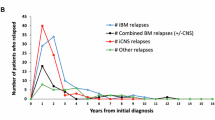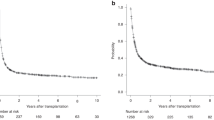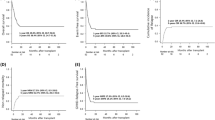Abstract
In 1989 we carried out a trial comparing allogeneic BMT to chemotherapy (CT) in 76 children with relapsed acute lymphoblastic leukaemia (ALL). Ten years on we have clinically revised outcome to firmly establish the role of each treatment, to analyse the importance of length of first remission and to provide long-term actuarial results for disease-free survival (DFS) and relapse rate in each group. For 21 patients within the transplantation group, probability of DFS and relapse are 42.8 ± 10.8% and 40.2 ± 11.7% (s.e.), respectively. In the chemotherapy group, probability of DFS is 10.0 ± 4.74% (P = 0.001) and probability of relapse 87.5 ± 5.2% (P = 0.0004). These results strongly reflect those at initial analysis, confirming a key role of BMT in the management of ALL in second remission. Moreover, on univariate analysis only two factors influenced DFS: treatment group and length of first complete remission (less or more than 30 months from first CR). Thus, it seems clear that the best therapeutic option in early relapse is BMT, whereas DFS in late relapse is at the limit of significance (P = 0.07), with a higher relapse rate in the CT group. Although encouraging results using intensified rotational combination chemotherapy have been published, prospective randomised studies are needed to assess with certainty the best therapeutic option in these patients.
This is a preview of subscription content, access via your institution
Access options
Subscribe to this journal
Receive 12 print issues and online access
$259.00 per year
only $21.58 per issue
Buy this article
- Purchase on SpringerLink
- Instant access to full article PDF
Prices may be subject to local taxes which are calculated during checkout
Similar content being viewed by others
Author information
Authors and Affiliations
Rights and permissions
About this article
Cite this article
Torres, A., Alvarez, M., Sánchez, J. et al. Allogeneic bone marrow transplantation vs chemotherapy for the treatment of childhood acute lymphoblastic leukaemia in second complete remission (revisited 10 years on). Bone Marrow Transplant 23, 1257–1260 (1999). https://doi.org/10.1038/sj.bmt.1701802
Received:
Accepted:
Published:
Issue date:
DOI: https://doi.org/10.1038/sj.bmt.1701802
Keywords
This article is cited by
-
How to Treat Relapsed Acute Lymphoblastic Leukemia: Transplant vs. Conventional Chemotherapy
The Indian Journal of Pediatrics (2013)
-
Allogeneic hematopoietic cell transplantation outcomes for children with B-precursor acute lymphoblastic leukemia and early or late BM relapse
Bone Marrow Transplantation (2011)
-
Long-term outcome of allogeneic or autologous haemopoietic cell transplantation for acute lymphoblastic leukaemia in second remission in children. GETMON experience 1983–1998
Bone Marrow Transplantation (2005)
-
Allogeneic bone marrow transplantation for childhood relapsed acute lymphoblastic leukemia: comparison of outcome in patients with and without a matched family donor
Bone Marrow Transplantation (2002)
-
Long-Term Outcome of Treatment With Protocols AL841, AL851, and ALHR88 in Children With Acute Lymphoblastic Leukemia: Results Obtained by the Kyushu-Yamaguchi Children’s Cancer Study Group
International Journal of Hematology (2001)



